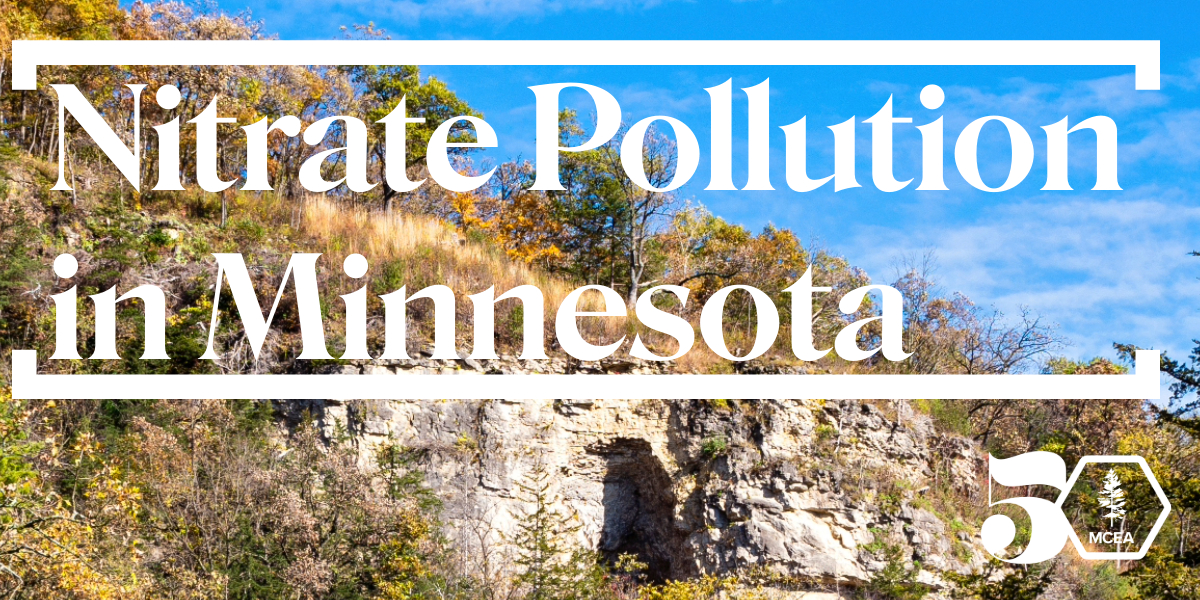Blog Post: MCEA is Pushing for Progress on Nitrate Pollution at the Legislature

By: Akilah Sanders-Reed, MCEA Program Associate
The same features of southeastern Minnesota that make it so beautiful–such as the groundwater-fed trout streams, dramatic bluffs, and underground caves–also make it very vulnerable to groundwater contamination. In this hydrologically sensitive part of the state, nitrate pollution is seeping into the water and endangering people, fish, and aquatic ecosystems.
As a rural farming region, this area of the state is home to many of our midsize dairy farms, feedlots, and corn and soybean row crop acres - as well as residents who rely on private wells for their drinking water. These homes and farms are built on a unique geologic formation called karst, where the topsoil is shallow and the limestone bedrock is fractured in “swiss-cheese-like” formations, allowing rapid infiltration of contaminants from the surface into the groundwater. This combination has created a perfect storm for a public health crisis from widespread nitrate contamination.
Nitrogen is a nutrient that comes in many different forms and is critical for plant growth. But when it’s applied in excessive quantities, excess nitrogen can be released into the atmosphere as nitrous oxide (a dangerous greenhouse gas) or leach into the groundwater as nitrate, a form of nitrogen that is dangerous for human health. Nitrate contamination has been linked to a variety of cancers, thyroid disease, and pregnancy complications, as well as lethal blue-baby syndrome (methemoglobinemia). In southeastern Minnesota, nitrate levels routinely exceed federal and state drinking water standards.
Private well owners in rural areas are at especially high risk because after their well has been drilled, there are no requirements or dedicated resources to test or treat their water supply for contaminants like nitrates. State agency data shows that 16% of wells tested across Southeast Minnesota exceed the federal human health limit for nitrate from 2018-2022. The U.S. Environmental Protection Agency (EPA) estimates that nearly 10,000 households have well water that exceeds these standards.
So where is this nitrate pollution coming from?
In the Lower Mississippi River Basin where the karst region is located, 89% of the nitrogen pollution in surface waters comes from cropland sources.1 One of the primary cropland sources is the land application of commercial fertilizer and manure from feedlots. When manure storage systems at feedlots reach capacity, the feedlot must empty them by spreading the manure onto cropland as a fertilizer.
In Minnesota, large feedlots with over 1,000 animals are required to provide nine months of manure storage as a condition of their permits, but feedlots under that threshold often don’t maintain as much storage. This increases the likelihood that they will need to offload manure at rates above crop needs or at riskier times of the year, like when the ground is frozen and unable to absorb the manure nutrients. Most farmers care deeply about stewardship of their land and the health of their neighbors, but our policies do not reflect that; instead, they make polluting actions cheaper and more accessible than sustainable practices.
MCEA is working on a bill this session to change that.
The Manure Management Grants bill (HF 3493 / SF 3527), introduced by Rep. Kristi Pursell and Sen. Heather Gustafson, would create a grant program through the Board of Water and Soil Resources to help feedlots with less than 1,000 animal units in vulnerable groundwater areas implement manure management best practices that improve water quality and reduce greenhouse gas emissions.
Over 90% of the more than 2,600 feedlots in southeastern Minnesota have fewer than 1,000 animal units.2 One of the key barriers to improved manure management for these operations is the up-front capital costs of building out manure storage capacity and other manure management systems. This bill provides cost-sharing assistance for that infrastructure to make implementing best practices financially feasible, and prioritizes applicants who commit to following the more stringent land application standards required of larger feedlots, such as restrictions on spreading manure in winter.
In addition to cost sharing assistance for manure management and storage facilities, the bill would also establish dedicated funding for other nitrate pollution mitigation projects that would help protect vulnerable groundwater from further contamination such as conservation easements3 and buffer zones around particular karst features.
This bill builds on years of work to address this crisis. In April 2023, MCEA and ten other local, state, and national environmental groups filed a petition to the EPA asking for emergency action to address the drinking water crisis in southeastern Minnesota.4 In November 2023, the EPA responded with a warning to Minnesota’s state agencies saying the state needed to take immediate action to safeguard public health.5
The Manure Management Grants bill is aligned with the EPA’s directive, as well as the Minnesota Pollution Control Agency’s (MPCA) commitment to addressing fish kills caused by runoff. Providing grant funding specifically to farmers in southeastern Minnesota to expand manure storage was one of the MPCA’s top recommendations in a report earlier this year.
By pursuing policies that help farmers implement solutions, MCEA is helping Minnesota curb the crisis and protect southeastern Minnesota’s drinking water.
You can learn more about nitrate pollution and drinking water at our critical conversations page.
Sources:
1. MPCA Nitrogen in MN Surface Waters 2013 https://www.pca.state.mn.us/sites/default/files/wq-s6-26a.pdf
2. Fishkills report pg4 https://www.lrl.mn.gov/docs/2024/mandated/240087.pdf
3. https://bwsr.state.mn.us/what-are-conservation-easements
4. https://www.mncenter.org/press-release-environmental-groups-petition-epa-use-emergency-authority-address-imminent-threat
5. https://www.epa.gov/system/files/documents/2023-11/ao-rmod-reponse-letter_20230510-508.pdf